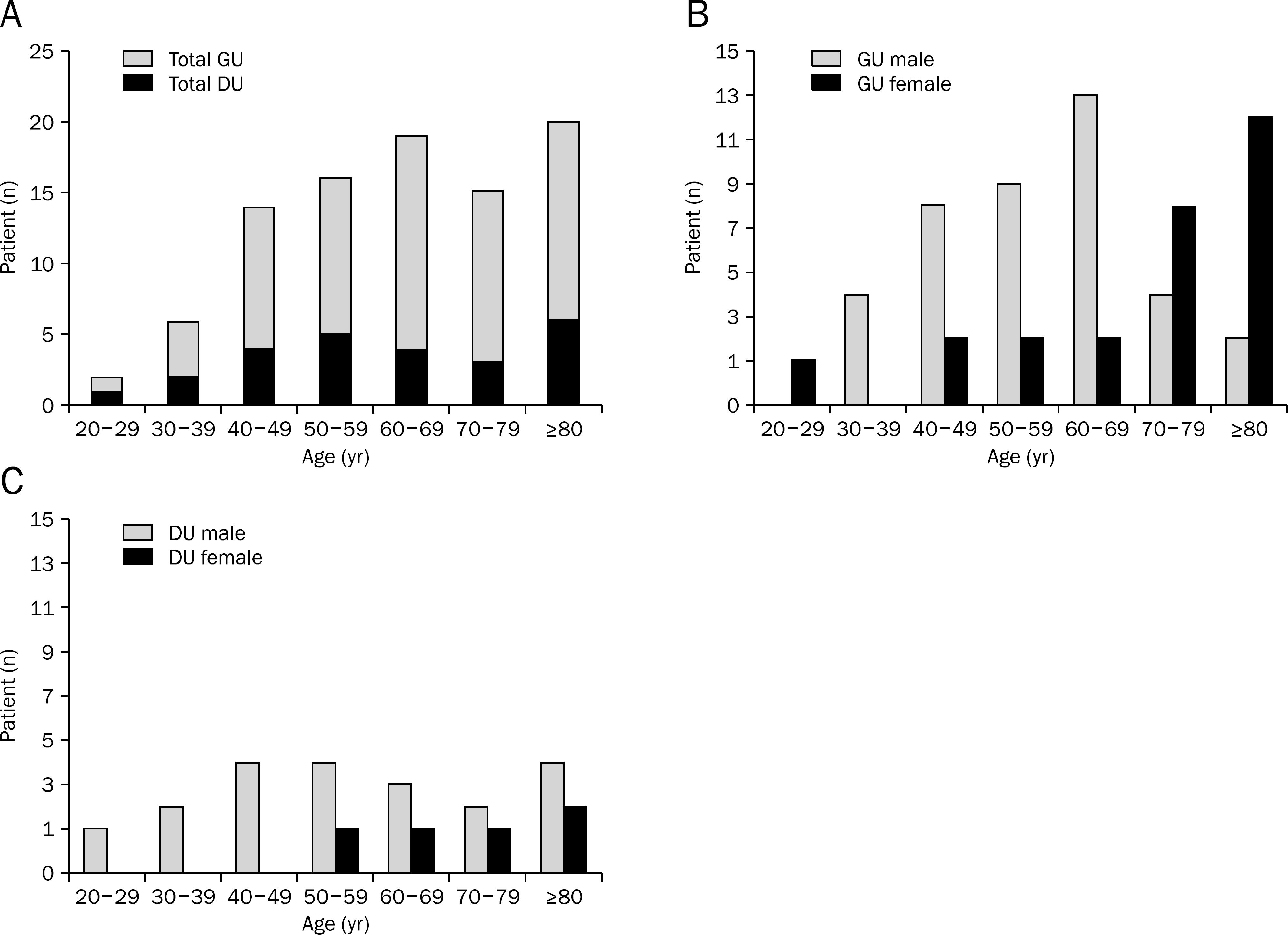Korean J Gastroenterol.
2016 Aug;68(2):77-86. 10.4166/kjg.2016.68.2.77.
Optimal Operational Definition of Patient with Peptic Ulcer Bleeding for Big Data Analysis Using Combination of Clinical Characteristics in a Secondary General Hospital
- Affiliations
-
- 1Department of Internal Medicine and Wonkwang Digestive Disease Research Institute, Wonkwang University Sanbon Hospital, Wonkwang University College of Medicine, Gunpo, Korea.
- 2Department of Medical Record, Wonkwang University Sanbon Hospital, Wonkwang University College of Medicine, Gunpo, Korea.
- 3Big Data Steering Department, National Health Insurance Service, Wonju, Korea. wms89@hanmail.net
- 4Department of Internal Medicine, Asan Medical Center, University of Ulsan College of Medicine, Seoul, Korea.
- 5Scientific Committee of the Korean College of Helicobacter and Upper Gastrointestinal Research, Seoul, Korea.
- KMID: 2350084
- DOI: http://doi.org/10.4166/kjg.2016.68.2.77
Abstract
- BACKGROUND/AIMS
Peptic ulcer bleeding (PUB) is the most common cause of upper gastrointestinal bleeding in Korea but there has been no research done using big data. This study evaluates the optimal operational definition (OD) for big data research by analyzing clinical characteristics of PUB.
METHODS
We reviewed the clinical characteristics of 92 patients with PUB confirmed on endoscopy in Wonkwang University Sanbon Hospital (January 2013 to December 2014). We calculated sensitivity and positive predictive value (PPV) to detect confirmed PUB patients using ODs developed by combining clinical features of patients with PUB.
RESULTS
The mean patient age was 63 years. Men had higher prevalence of PUB than women. Bleeding gastric ulcer was proportionately common in the age range of 40s to 60s in men, while a significantly higher rate of bleeding occurred in women older than 70s. The rate of drug-induced ulcer was 28.2%, whereas the prevalence of Helicobacter pylori was 47.8%. Among the hospitalized patients with diagnostic code of PUB, we ruled out patients with endoscopic removal of gastric adenoma or peritonitis, and selected patients who had been administered intravenous proton pump inhibitor. The sensitivity in this setting was 82.6%, and PPV was 88.4%.
CONCLUSIONS
PUB was more common in older patients, and there was a clear gender difference in gastric ulcer bleeding by age. With a proper OD using PUB diagnostic codes, we can identify true patients with sufficiently high sensitivity and PPV.
Keyword
MeSH Terms
Figure
Reference
-
References
1. Kurien M, Lobo AJ. Acute upper gastrointestinal bleeding. Clin Med (Lond). 2015; 15:481–485.
Article2. Sung JK. Diagnosis and management of peptic ulcer bleeding. Korean J Med. 2015; 88:156–160.
Article3. Wu CY, Wu CH, Wu MS, et al. A nationwide population-based cohort study shows reduced hospitalization for peptic ulcer disease associated with H pylori eradication and proton pump inhibitor use. Clin Gastroenterol Hepatol. 2009; 7:427–431.4. Ahsberg K, Ye W, Lu Y, Zheng Z, Staël von Holstein C. Hospitalisation of and mortality from bleeding peptic ulcer in Sweden: a nationwide time-trend analysis. Aliment Pharmacol Ther. 2011; 33:578–584.5. Theocharis GJ, Thomopoulos KC, Sakellaropoulos G, Katsakoulis E, Nikolopoulou V. Changing trends in the epidemiology and clinical outcome of acute upper gastrointestinal bleeding in a defined geographical area in Greece. J Clin Gastroenterol. 2008; 42:128–133.
Article6. Kwon JH, Choi MG, Lee SW, et al. Trends of gastrointestinal diseases at a single institution in Korea over the past two decades. Gut Liver. 2009; 3:252–258.
Article7. Nagasue T, Nakamura S, Kochi S, et al. Time trends of the impact of Helicobacter pylori infection and nonsteroidal anti-inflammatory drugs on peptic ulcer bleeding in Japanese patients. Digestion. 2015; 91:37–41.8. Choi JW, Kim HY, Kim KH, et al. Has any improvement been made in the clinical outcome of patients with bleeding peptic ulcer in the part 10 years? Korean J Gastrointest Endosc. 2005; 30:235–242.9. Kim JJ, Kim N, Lee BH, et al. Risk factors for development and recurrence of peptic ulcer disease. Korean J Gastroenterol. 2010; 56:220–228.
Article10. Na YJ, Shim KN, Kang MJ, et al. Comparison of clinical characteristics and outcomes between geriatric and non-geriatric patients in peptic ulcer bleeding. Korean J Gastroenterol. 2009; 53:297–304.
Article11. Bae SO, Kang GW. A comparative study of the disease codes between Korean national health insurance vlaims and Korean national hospital discharge in-depth injury survey. Health Policy Manag. 2014; 24:322–329.12. Bae S, Kim N, Kang JM, et al. Incidence and 30-day mortality of peptic ulcer bleeding in Korea. Eur J Gastroenterol Hepatol. 2012; 24:675–682.
Article13. Kim JJ, Kim N, Park HK, et al. Clinical characteristics of patients diagnosed as peptic ulcer disease in the third referral center in 2007. Korean J Gastroenterol. 2012; 59:338–346.
Article14. Huang JQ, Sridhar S, Hunt RH. Role of Helicobacter pylori infection and non-steroidal anti-inflammatory drugs in peptic-ulcer disease: a metaanalysis. Lancet. 2002; 359:14–22.15. Lim SH, Kwon JW, Kim N, et al. Prevalence and risk factors of Helicobacter pylori infection in Korea: nationwide multicenter study over 13 years. BMC Gastroenterol. 2013; 13:104.
Article16. Güell M, Artigau E, Esteve V, Sánchez-Delgado J, Junquera F, Calvet X. Usefulness of a delayed test for the diagnosis of Helicobacter pylori infection in bleeding peptic ulcer. Aliment Pharmacol Ther. 2006; 23:53–59.17. Ko MJ, Lim TH. Use of big data for evidence-based healthcare. J Korean Med Assoc. 2014; 57:413–418.
Article18. Park BJ. Application of big data for public health. J Korean Med Assoc. 2014; 57:383–385.
Article19. Gilbert DA, Saunders DR. Iced saline lavage does not slow bleeding from experimental canine gastric ulcers. Dig Dis Sci. 1981; 26:1065–1068.
Article20. Palamidessi N, Sinert R, Falzon L, Zehtabchi S. Nasogastric aspiration and lavage in emergency department patients with hematochezia or melena without hematemesis. Acad Emerg Med. 2010; 17:126–132.
Article21. Czernichow P, Hochain P, Nousbaum JB, et al. Epidemiology and course of acute upper gastrointestinal haemorrhage in four French geographical areas. Eur J Gastroenterol Hepatol. 2000; 12:175–181.
Article
- Full Text Links
- Actions
-
Cited
- CITED
-
- Close
- Share
- Similar articles
-
- Endoscopic Management of Peptic Ulcer Bleeding
- Endoscopic Hemostatic Treatment of Peptic Ulcer Bleeding
- Management of Peptic Ulcer Bleeding in Patients Taking Aspirin or Anticoagulant
- Diagnosis and Management of Peptic Ulcer Bleeding
- Comparison of the Effectiveness of Interventional Endoscopy in Bleeding Peptic Ulcer Disease according to the Timing of Endoscopy


